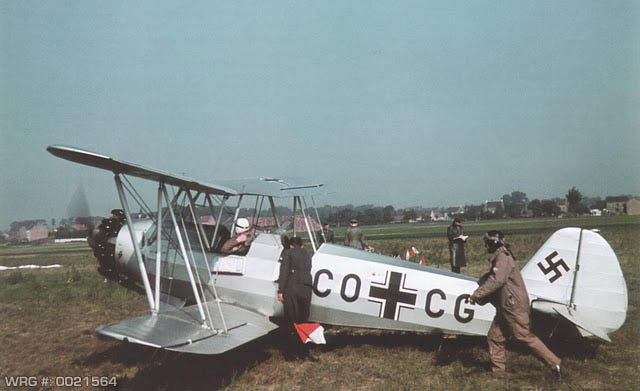LUFTWAFFE RESOURCE CENTER > TRAINERS > PREVIOUS PAGE
Heinkel He 72 Kadett

[Source: Mark Allen Collection]
The Kadett was designed in 1933 to meet an official requirement for a basic trainer. It was a single-bay biplane of fabric-covered, metal construction with open cockpits, a staggered wing, a strut-braced tail unit, and fixed tailskid undercarriage. The prototype was powered by a 104 kW (139 hp) Argus As 8B air-cooled inline engine.
The first production model, the He 72A retained the As 8B engine in early batches, but later production aircraft had a 112 kW (150 hp) As 8R. The He 72A was superseded by the He 72B, which was the major production version. This was powered by a 120 kW (160 bhp) Siemens-Halske Sh 14A radial.
The He 72B was produced as the He 72B-1 landplane and He 72BW Seekadett ("Sea Cadet") twin-float seaplane. The civil development was the He 72B-3 Edelkadett ("Noble Cadet").
The Kadett entered service with National Socialist Flyers Corps before the formation of the Luftwaffe. Later, it became a standard basic trainer with the Luftwaffe. Slovak forces used it in the attack role.
Type: Primary Trainer
Origin: Ernst Heinkel AG
Crew: Two
Models: He 72A, He 72B
First Flight: 1933
Service Delivery: 1934
Final Delivery: 1936
Total Production: 2,000+
Powerplant:
He 72A:
Model: Argus As 8B
Type: air cooled inverted vee
Numer: One Horsepower: 140 hp
He 72B:
Model: Siemens Sh 14A
Type: 7-Cylinder radial
Numer: One Horsepower: 160 hp
Dimensions:
Wing span: 29 ft. 6¼ in. (9.00m)
Length: 24 ft. 7¼ in. (7.50m)
Height: 8 ft. 10¼ in. (2.70m)
Wing Surface Area: N/A
Weights: He 72B
Empty: 1,191 lbs. (540 kg.)
Maximum: 1,907 lbs. (865 kg.)
Performance: He 72B
Maximum Speed: 115 mph (185 kph)
Service Ceiling: N/A
Range: 510 miles (820 km)
Armament:
N/A
|
Sources:
Wikipedia
LUFTWAFFE RESOURCE CENTER > TRAINERS > PREVIOUS PAGE

